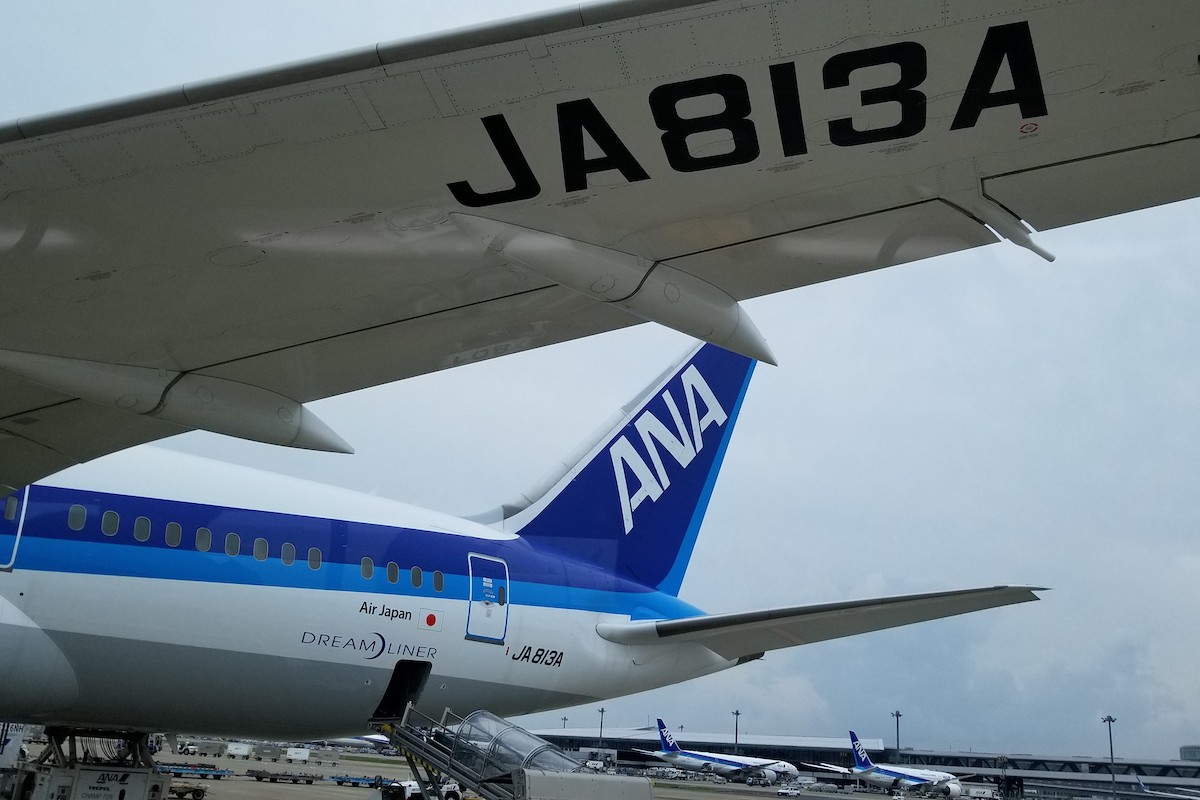Photo credit: An ANA Boeing 787 in Tokyo Flickr / lamblukas
Japan’s All Nippon Airways has seen a jump in passengers traveling between the U.S. and China as geopolitical tension keeps nonstop flights between the two countries at historic lows.
ANA is seeing “new demand” from travelers who transit its Tokyo hubs on trips between the U.S. and China, President and CEO Shinichi Inoue said at the IATA Annual General Meeting in Istanbul Monday. While he did not indicate just how much travel demand in the market was up, he did say that transit traffic overall was one of the most recovered segment’s of the airline’s business.
Roughly two-thirds of the Japanese carrier’s international business outside of China has returned, Inoue said. Travel demand from China to Japan remains weak due to remaining Covid travel restrictions, as well as outbound travel from Japan. ANA expects international travel demand to recover to roughly 80 percent of 2019 levels by the end of its fiscal year, or by March 2024.
Nonstop flights between the U.S. and China are capped at Covid-era levels of 12 per week for each country. That translates to four weekly flights each for American Airlines, Delta Air Lines, and United Airlines; and three each for Air China, China Eastern Airlines, China Southern Airlines, and Xiamen Airlines. The Chinese carriers recently gained four weekly flights to bring them to parity with their U.S. counterparts.
For comparison, there were up to 54 nonstop flights a day between the countries in 2019.
The weekly flight limits are a holdover from China’s zero-Covid policy that ended late last year. In January, the country eased border restrictions to both Chinese and foreign travelers, and allowed both domestic and airlines from select countries to begin resuming their pre-pandemic schedules. Foreign airlines including AirAsia, ANA, Cathay Pacific Airways, Finnair, Japan Airlines, Korean Air, and Lufthansa have all added back flights over the past six months.
But U.S.-China flights have not begun returning to 2019 levels. The Sino-American relationship was strained at the beginning of the pandemic in part thanks to the protectionist trade policy of U.S. President Donald Trump’s administration. Tensions increased after then Speaker of House Nancy Pelosi’s trip to Taiwan last August. Positively, Reuters reported Tuesday the countries had agreed to keep communication lines between them open amid heightened tensions in the Taiwan Strait.
Sticking Points
In terms of flights, reports indicate that the latest sticking point between the U.S. and China is over Chinese airlines’ use of Russian airspace for U.S. flights. American carriers are barred from overflying the country due to Russia’s war in Ukraine. United CEO Scott Kirby on Monday highlighted concerns about the safety of U.S. citizens if a flight passing through Russian airspace was forced to divert to a Russian airport.
The four weekly U.S.-China flights that Chinese airlines added in recent weeks have avoided Russian airspace even as other flights do not, according to Flightradar24.
“TBD on growth to China. A lot of uncertainty there,” Kirby said at the meeting. He added that he was “gratified” by the “resolution” that Chinese airlines would avoid Russian airspace with the four additional flights.
United was the largest U.S. airline to China prior to the pandemic. It operated up to 10 daily flights to Beijing, Chengdu, and Shanghai from Chicago, Los Angeles, Newark, San Francisco, and Washington, D.C., in 2019, according to Cirium Diio schedules.
ANA, as well its competitors JAL and Korean Air, are uniquely positioned to benefit from the limited number of U.S.-China nonstops. Their hubs in Tokyo and Seoul are ideally placed to connect travelers between North American cities and China, and have few if any restrictions on flights as to China. In addition, ANA has a close joint venture partnership with United, JAL with American, and Korean Air with Delta.
Korean Air highlighted “strong demand” for travelers transiting between the Americas and both China and Southeast Asia in its first-quarter results. The airline posted a 13 percent operating margin in the first quarter.
ANA, which is further behind in its recovery than Korean Air, reported a 7 percent operating margin on a “dramatic” improvement in international demand for the quarter ending in March.
In June, seats on ANA to China are at 48 percent of 2019 levels, Diio data show. Korean Air is at 43 percent and JAL, the smallest of the three carriers to China, at 59 percent. However, Korean Air remains the largest of the three to China by far, operating 80 percent more seats than ANA — the second largest of the group — compared to nearly 60 percent more four years ago.
Seats on the three airlines and their partners to the U.S. are nearly recovered. ANA and United will operate 93 percent of their pre-pandemic seats between Japan and U.S. in June, according to Diio. Korean Air and Delta will fly 89 percent of 2019 seats, though the U.S. carrier is 8 percent larger, and JAL and American 80 percent.
Special Offer: Choose From Quarterly or Annual Subscription Plans
{{monthly_count}} of {{monthly_limit}} free stories left to read
SubscribeAlready a member? Sign in here
You Need an Airline Weekly Susbcription to Read This Story
Your story count resets on {{monthly_reset}}
Already a member? Sign in here
